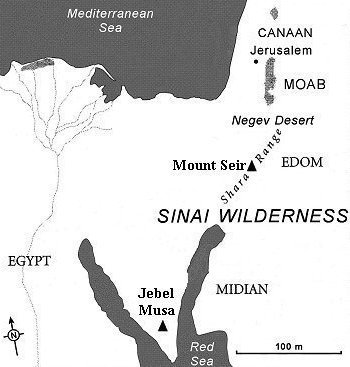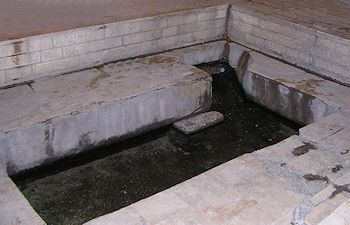Page 4 of 12
The Templars and the Ark of the Covenant


Remarkably, the local Bedouin of the Shara Range have long held the tradition that Jebel Madhbah was the true Mount Sinai. Often in the Bible, Mount Sinai is referred to as Horeb (“sacred desert mountain”) and, according to the book of Exodus, when the Israelites first arrived here God commanded Moses to use his sacred staff to create a miraculous spring:
The Sinai Wilderness and surrounding area at the time of Moses, circa 1300 BC.
Moses creating the miraculous spring at the foot of Mount Sinai.
Mount Sinai would have been an understandable place for Jeremiah to have taken the Ark. It was not only the sacred location where the Ark was originally made and the Ten Commandments were received, it was also considered the place were God resided. Unfortunately, the Bible does not directly tell us where it is.
Since Roman times legend has identified Mount Sinai as Jebel Musa in eastern Egypt – the site that tourists and pilgrims still visit today. This tradition originated with a religious vision said to have been experienced by the Roman Empress Helena around 325 AD. Nevertheless, there is no actual biblical or archaeological evidence for it. In modern times biblical scholars have fiercely debated Mount Sinai’s true location, and to this day it remains one of the Bible’s most contested mysteries. However, if we examine the Old Testament carefully, it does provide important clues that seem to have been completely overlooked.
According to the Old Testament, Moses first discovered God on Mount Sinai when he spoke to him from a burning bush. According to the Book of Exodus, the event occurred when Moses traveled to the far side of the Sinai Wilderness from the land of Midian, where he was living after being exiled from Egypt (Exodus 3:1). Midian was near the Red Sea, and so the far side of the Sinai Wilderness from its location would place it in the land then called Edom – now southern Jordan.
Lord, when thou wentest out of Seir, when thou marchedst out of the field of Edom, the earth trembled, and the heavens dropped, the clouds also dropped water. The mountains melted from before the Lord, even that Sinai from before the Lord God of Israel.
The most telling biblical references placing the Mount Sinai in Edom concern a mountain range that the ancient Israelites called Seir – now called the Shara Range around the ancient city of Petra in what had once been the land of Edom. God is said to have resided on Mount Sinai and there are repeated references in the Old Testament to God residing in Seir. The prophet Isaiah, for instance, tells us that when God speaks to him, “He calleth to me out of Seir” (Isaiah 21:11). A particular mountain in the range is specifically referred to as Mount Seir. The prophet Ezekiel, for example, tells his followers to “set thy face against mount Seir” (Ezekiel 35:2). One particular passage leaves us with little doubt that God was thought to reside here and that Mount Sinai is somewhere in the Seir Range. In the Book of Judges 5:4-5, the prophetess Deborah prays to God:
The Old Testament Book of Deuteronomy 33:2 is even more specific. When Moses is dying he calls upon God to bless the children of Israel and “the Lord came from Sinai and rose up from Seir unto them”. Not only is this evidence that God was thought to reside in Seir but that Mount Seir is another name for Mount Sinai. Today Mount Seir is known by its Arab name of Jebel Madhbah, one of the highest mountains in the Shara Range in what is now southern Jordan.
Where was Mount Sinai?

Behold I will stand before thee there upon the rock in Horeb; and thou shalt smite the rock, and there shall come water out of it. (Exodus 17:6)
A Bedouin shrine still marks the spot at the foot of Jebel Madhbah where local tradition says the event occurred. Inside, the spring that bubbles up from below is called Ain Musa – the spring of Moses.
Ain Musa - The Spring of Moses - said to be the miraculous spring created by Moses himself.

Jebel Madhbah in Jordan. Is the real Mount Sinai?








